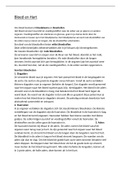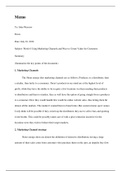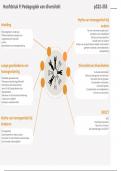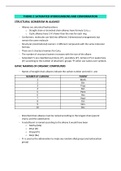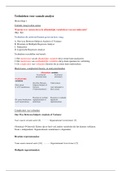ECS2602 EXAM
PACK
,Contents
Welcome ....................................................................................................................................................................... 3
October/November 2015 Exam .............................................................................................................................. 4
Section A ................................................................................................................................................................. 4
Section B Questions ............................................................................................................................................ 12
Section B Answers ............................................................................................................................................... 19
May/June 2015 Exam .............................................................................................................................................. 20
Section A ............................................................................................................................................................... 20
Section B Questions ............................................................................................................................................ 26
Section B Answers ............................................................................................................................................... 32
October/November 2014 Exam ............................................................................................................................ 33
Section A ............................................................................................................................................................... 33
Section B Questions ............................................................................................................................................ 42
Section B Answers ............................................................................................................................................... 48
May/June 2014 Exam .............................................................................................................................................. 49
Section A ............................................................................................................................................................... 49
Section B Questions ............................................................................................................................................ 58
Section B Answers ............................................................................................................................................... 65
Additional MCQs...................................................................................................................................................... 66
Additional MCQs’ Answers ..................................................................................................................................... 79
Thank You................................................................................................................................................................. 80
Pg.2
,October/November 2015 Exam
Section A
Question 1.1
The multiplier effect in the economy results from the behaviour of households. Briefly explain why.
Every time there is an injection of new demand into the circular flow there is likely to be a multiplier effect. This
is because an injection of extra income leads to more spending, which creates more income, and so on. The
multiplier effect refers to the increase in final income arising from any new injection of spending.
The size of the multiplier depends upon household’s marginal decisions to spend, called the marginal
propensity to consume (mpc), or to save, and called the marginal propensity to save (mps).
It is important to remember that when income is spent, this spending becomes someone else’s income, and so
on.
Question 1.2
Taxes are part of autonomous spending in the goods market model. Briefly explain why a decrease in
taxes increases the demand for goods and shifts the demand for goods curve upwards in the goods
market, equal to c (T) and not T.
C + I + G + (Ex - Im) formula increases, then GDP—total demand—increases. If the ―G‖ portion—government
spending at all levels—increases, then GDP increases. Similarly, if government spending decreases, then GDP
decreases.
By increasing or decreasing taxes, the government affects households' level of disposable income (after-tax
income). A tax increase will decrease disposable income, because it takes money out of households. A tax
decrease will increase disposable income, because it leaves households with more money. Disposable income
is the main factor driving consumer demand, which accounts for two-thirds of total demand.
Taxes lower households' disposable income. The amount collected in taxes doesn't find its way into
consumption (―C‖). But if the government spends every dollar that it collects in taxes, then that amount does
find its way into total demand through government expenditures. When that occurs, the GDP remains
unaffected by taxes. The size of the economy is the same whether people choose to produce and consume
private goods (angora sweaters) or public goods (army uniforms). The mix of goods doesn't affect the level of
GDP, as long as the total amount spent on them doesn't change.
A decrease in taxes has the opposite effect on income, demand, and GDP. It will boost all three, which is why
people cry out for a tax cut when the economy is sluggish. When the government decreases taxes, disposable
income increases. That translates to higher demand (spending) and increased production (GDP). So, the fiscal
policy prescription for a sluggish economy and high unemployment is lower taxes.
Spending policy is the mirror image of tax policy. If the government were to keep taxes the same, but decrease
its spending, it would have the same effect as a tax increase, but through a slightly different channel. Instead of
decreasing disposable income and decreasing consumption (―C‖), a decrease in government spending
decreases the ―G‖ in C + I + G directly. The lower demand flows through to the larger economy, slows growth
in income and employment, and dampens inflationary pressure.
Question 1.3
Pg.4
, Explain briefly in words why the net effect of an equal increase in government spending and taxes ( in
other words, the balanced budget) will still have a stimulatory effect on the level of output and income.
A tax increase will decrease disposable income, because it takes money out of households. A tax decrease will
increase disposable income, because it leaves households with more money.
Disposable income is the main factor driving consumer demand, which accounts for two-thirds of total
demand.
The fiscal multiplier (not to be confused with monetary multiplier) is the ratio of a change in national income
to the change in government spending that causes it. More generally, the exogenous spending multiplier is the
ratio of a change in national income to any autonomous change in spending (private investment spending,
consumer spending, government spending, or spending by foreigners on the country's exports) that causes it.
When this multiplier exceeds one, the enhanced effect on national income is called the multiplier effect. The
mechanism that can give rise to a multiplier effect is that an initial incremental amount of spending can lead
to increased consumption spending, increasing income further and hence further increasing consumption, etc.,
resulting in an overall increase in national income greater than the initial incremental amount of spending. In
other words, an initial change in aggregate demand may cause a change in aggregate output (and hence the
aggregate income that it generates) that is a multiple of the initial change.
The higher is the propensity to consume domestically produced goods and services, the greater is the multiplier
effect. The government can influence the size of the multiplier through changes in direct taxes. For example, a
cut in the rate of income tax will increase the amount of extra income that can be spent on further goods and
services.
Question 1.4
By using the two diagrams below, show the difference between a decrease in investment spending in
the marginal propensity to consume on the equilibrium output and income level in the goods market
model.
Decrease in Investment Spending
Decrease in Marginal Propensity to Consume
Pg.5
PACK
,Contents
Welcome ....................................................................................................................................................................... 3
October/November 2015 Exam .............................................................................................................................. 4
Section A ................................................................................................................................................................. 4
Section B Questions ............................................................................................................................................ 12
Section B Answers ............................................................................................................................................... 19
May/June 2015 Exam .............................................................................................................................................. 20
Section A ............................................................................................................................................................... 20
Section B Questions ............................................................................................................................................ 26
Section B Answers ............................................................................................................................................... 32
October/November 2014 Exam ............................................................................................................................ 33
Section A ............................................................................................................................................................... 33
Section B Questions ............................................................................................................................................ 42
Section B Answers ............................................................................................................................................... 48
May/June 2014 Exam .............................................................................................................................................. 49
Section A ............................................................................................................................................................... 49
Section B Questions ............................................................................................................................................ 58
Section B Answers ............................................................................................................................................... 65
Additional MCQs...................................................................................................................................................... 66
Additional MCQs’ Answers ..................................................................................................................................... 79
Thank You................................................................................................................................................................. 80
Pg.2
,October/November 2015 Exam
Section A
Question 1.1
The multiplier effect in the economy results from the behaviour of households. Briefly explain why.
Every time there is an injection of new demand into the circular flow there is likely to be a multiplier effect. This
is because an injection of extra income leads to more spending, which creates more income, and so on. The
multiplier effect refers to the increase in final income arising from any new injection of spending.
The size of the multiplier depends upon household’s marginal decisions to spend, called the marginal
propensity to consume (mpc), or to save, and called the marginal propensity to save (mps).
It is important to remember that when income is spent, this spending becomes someone else’s income, and so
on.
Question 1.2
Taxes are part of autonomous spending in the goods market model. Briefly explain why a decrease in
taxes increases the demand for goods and shifts the demand for goods curve upwards in the goods
market, equal to c (T) and not T.
C + I + G + (Ex - Im) formula increases, then GDP—total demand—increases. If the ―G‖ portion—government
spending at all levels—increases, then GDP increases. Similarly, if government spending decreases, then GDP
decreases.
By increasing or decreasing taxes, the government affects households' level of disposable income (after-tax
income). A tax increase will decrease disposable income, because it takes money out of households. A tax
decrease will increase disposable income, because it leaves households with more money. Disposable income
is the main factor driving consumer demand, which accounts for two-thirds of total demand.
Taxes lower households' disposable income. The amount collected in taxes doesn't find its way into
consumption (―C‖). But if the government spends every dollar that it collects in taxes, then that amount does
find its way into total demand through government expenditures. When that occurs, the GDP remains
unaffected by taxes. The size of the economy is the same whether people choose to produce and consume
private goods (angora sweaters) or public goods (army uniforms). The mix of goods doesn't affect the level of
GDP, as long as the total amount spent on them doesn't change.
A decrease in taxes has the opposite effect on income, demand, and GDP. It will boost all three, which is why
people cry out for a tax cut when the economy is sluggish. When the government decreases taxes, disposable
income increases. That translates to higher demand (spending) and increased production (GDP). So, the fiscal
policy prescription for a sluggish economy and high unemployment is lower taxes.
Spending policy is the mirror image of tax policy. If the government were to keep taxes the same, but decrease
its spending, it would have the same effect as a tax increase, but through a slightly different channel. Instead of
decreasing disposable income and decreasing consumption (―C‖), a decrease in government spending
decreases the ―G‖ in C + I + G directly. The lower demand flows through to the larger economy, slows growth
in income and employment, and dampens inflationary pressure.
Question 1.3
Pg.4
, Explain briefly in words why the net effect of an equal increase in government spending and taxes ( in
other words, the balanced budget) will still have a stimulatory effect on the level of output and income.
A tax increase will decrease disposable income, because it takes money out of households. A tax decrease will
increase disposable income, because it leaves households with more money.
Disposable income is the main factor driving consumer demand, which accounts for two-thirds of total
demand.
The fiscal multiplier (not to be confused with monetary multiplier) is the ratio of a change in national income
to the change in government spending that causes it. More generally, the exogenous spending multiplier is the
ratio of a change in national income to any autonomous change in spending (private investment spending,
consumer spending, government spending, or spending by foreigners on the country's exports) that causes it.
When this multiplier exceeds one, the enhanced effect on national income is called the multiplier effect. The
mechanism that can give rise to a multiplier effect is that an initial incremental amount of spending can lead
to increased consumption spending, increasing income further and hence further increasing consumption, etc.,
resulting in an overall increase in national income greater than the initial incremental amount of spending. In
other words, an initial change in aggregate demand may cause a change in aggregate output (and hence the
aggregate income that it generates) that is a multiple of the initial change.
The higher is the propensity to consume domestically produced goods and services, the greater is the multiplier
effect. The government can influence the size of the multiplier through changes in direct taxes. For example, a
cut in the rate of income tax will increase the amount of extra income that can be spent on further goods and
services.
Question 1.4
By using the two diagrams below, show the difference between a decrease in investment spending in
the marginal propensity to consume on the equilibrium output and income level in the goods market
model.
Decrease in Investment Spending
Decrease in Marginal Propensity to Consume
Pg.5

